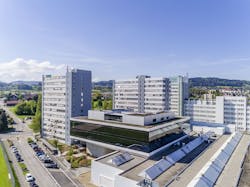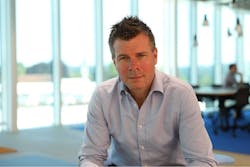Food and mobility industries get a boost of sustainability and efficiency
As digital officer at Bühler Group, Stuart Bashford is responsible for setting and delivering the company’s digitalization strategy. He began his career at Bühler in 2013 in London, as head of software and hardware development. Prior to joining Bühler, he worked at a high-tech startup company for 10 years designing control systems for lasers used in the solar panel and display industry. Prior to this he worked in the semiconductor industry for Applied Materials. He is MBA qualified and has a background in hardware and software design and a passion for technology and innovation.
Bühler is driven by its purpose of creating innovations for a better world, balancing the needs of economy, humanity and nature. As a solution partner for the food and mobility industries, Bühler is committed to reduce energy, waste and water in its customers’ value chains by 50% by 2025 (Figure 1). Bühler is in a position to turn today’s global challenges into sustainable business. Bühler contributes to safely feeding the world and is doing its part to protect the climate by producing solutions that make cars, buildings and machinery more energy efficient.
Bühler invests up to 5% of turnover into research and development, and in 2020, some 12,500 employees generated revenue of 2.7 billion Swiss francs (CHF), according to the company. As a Swiss family-owned company, Bühler is active in 140 countries around the world and operates a global network of 100 service stations, 33 manufacturing sites and application and training centers in 24 locations.
What are three key things that a machine builder, system integrator or manufacturer should know about your organization?
Stuart Bashford, digital officer, Bühler Group: Bühler has a huge amount of touch points with the global population. Billions of people come into contact with Bühler technologies as they cover their basic needs for food and mobility every day. Two billion people each day enjoy foods produced on Bühler equipment; and 1 billion people travel in vehicles manufactured using parts produced with Bühler technology. Countless people wear eyeglasses, use smart phones, and read newspapers and magazines, all of which depend on Bühler process technologies and solutions.
We are 100% focused on engineering our customers success, and two of the main pillars of our future strategy are sustainability and digitalization. We see digitalization as a key enabler for future business growth for our customers, and we want to be able to support our customers through their digital journey, wherever they may be on that journey, and become their solution partner of choice over the coming years.
What new technologies are driving product development and why?
Stuart Bashford, digital officer, Bühler Group: Digitalization across the board is key, and for us we look at connecting our assets—devices, machines, lines or plants—in order to deliver increased productivity. A key component of this is our industrial Internet of Things (IoT) platform, Bühler Insights, which allows us to deliver a variety of benefits to our customers, from reducing unplanned downtime to increasing yield or quality. For this, we have partnered with Microsoft, and we use its technology stack to build Bühler Insights. This allows us access to data. Then, of course, you need to be able to do something with that data, and for that we have a team of data scientists working full-time on building actionable insights from the huge amounts of process data that becomes available.
How does the industrial Internet of Things figure into business strategy?
Stuart Bashford, digital officer, Bühler Group: Industrial Internet of Things is a key part of our strategy. We see the cost of storage and transport of data reducing, and funding into deep tech sectors increasing; this creates a perfect storm of more and more development happening, which in turn drives industry to react, which then in turn drives more development and more funding. It is a virtuous circle that is moving faster and faster. What that means for all industrial organizations is increased competition. As an organization, our focus is to help our customers be as productive as they can possibly be and support them to rise to the top of their markets by offering solutions that maximize productivity.
How will machine automation and controls alter the way companies staff their operations in the future?
Stuart Bashford, digital officer, Bühler Group: As we look to the future, we can see there will be an impact on staffing. More and more operations become automated, meaning that there is less reliance on a human being. What we see at this time is that our solutions can alleviate key staff of some tasks, which enables them to do more value-added activities. For the time being, in our industries you still need the human in the loop. Looking further in the future, there will of course be some impact, as we have seen through the previous industrial revolutions, or if we look at other sectors such as automotive, where human-based production lines have given way to robotics-based autonomous process; but the impact will not be a step change. It will not happen overnight. The capabilities of the staffing requirements will also change. In the automotive industry example I used, someone still needs to service the robot.
How is the development of software solutions impacting requirements for hardware?
Stuart Bashford, digital officer, Bühler Group: At Bühler, we have had a tight alignment between hardware and software for many years, so this is not new for us. One area that can be challenging if not considered up front is data quality. At Bühler, we want to make a production line as high performance as possible, and for that we need to be able to access data from a variety of machines and then make use of that data in an automated way. This means you have to be thinking about how you structure data on the machine or sensor level, including any meta-data required to provide context for that data point, so that you can deliver benefits at the line or plant level.
As engineering and IT continue their convergence, which one is and/or will be leading the direction of future automation and technology?
Stuart Bashford, digital officer, Bühler Group: We see more and more blurring of the lines between IT and operational technology (OT). My view would be that IT will lead the way eventually, but they go hand in hand. You can only deliver maximum benefits with both IT and OT combined. At Bühler, our automation, digital and IT strategies are tightly aligned under an overarching digital strategy, which in turn is tightly coupled to our corporate strategy.
Looking into the future, how will technology change your organization or other organizations over the next five years?
Stuart Bashford, digital officer, Bühler Group: If we look over the next five years, I believe we will see great steps forward in our professional and private lives, all enabled by technology. It is an exciting time for everybody and definitely for someone working in these fields. It is great to be able to deliver increased functionality, all the time making our customers increasingly more productive.
We will see more solutions being offered where connectivity inside the plant and cloud-based becomes the norm; we will see more applications of autonomous operation, more applications for data sharing across the supply chain; and sustainability metrics will be a key driver of this. Capturing the carbon footprint across the value chain requires data sharing. We already see tangible outcomes for our customers using these technologies, and we absolutely see this trend continuing. Technology will also foster stronger and more impactful relationships with our customers. Let’s not forget that while technology can be very exciting, very often it is the people and the relationships that are built on top that bring the technology to the process. That is what delivers real results. The future is very, very exciting.
ALSO READ: Where is automation headed?
Mike Bacidore is the editor in chief for Control Design magazine. He is an award-winning columnist, earning a Gold Regional Award and a Silver National Award from the American Society of Business Publication Editors. Email him at [email protected].
About the Author
Mike Bacidore
Editor in Chief
Mike Bacidore is chief editor of Control Design and has been an integral part of the Endeavor Business Media editorial team since 2007. Previously, he was editorial director at Hughes Communications and a portfolio manager of the human resources and labor law areas at Wolters Kluwer. Bacidore holds a BA from the University of Illinois and an MBA from Lake Forest Graduate School of Management. He is an award-winning columnist, earning multiple regional and national awards from the American Society of Business Publication Editors. He may be reached at [email protected]

Leaders relevant to this article:



